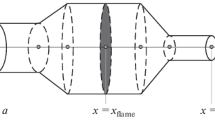Abstract
Combustion instability is a major issue in design of gas turbine combustors for efficient operation with low emissions. A transfer matrix-based approach is developed in this work for the stability analysis of gas turbine combustors. By viewing the combustor cavity as a one-dimensional acoustic system with a side branch, the heat source located inside the cavity can be described as the input to the system. The combustion process is modeled as a closed-loop feedback system, which enables utilization of well-established classic control theories for the stability analysis. Due to the inherent advantage of the transfer matrix method and control system representation, modeling and analysis of the system becomes a straightforward task even for a combustor of the complex geometry. The approach is applied to the stability analysis of a simple combustion system to demonstrate its validity and effectiveness.
Similar content being viewed by others
References
L. Crocco, Aspects of combustion instabilities in liquid propellant rocket motors, 1. Fundamentals — low frequency instability with monopropellants, Journal of the American Rocket Society, 21(6) (1951) 163–178.
F. E. C. Culick, Combustion instabilities in liquidfueled propulsion systems — An overview, AGARD Conference Proceedings, No. 450 (1989).
P. E. Dowling and S. R. Stow, Acoustic analysis of gas turbine combustors, Journal of Propulsion and Power, 19(5) (2003) 751–764.
G. A. Richards, D. L. Straub and E. H. Robey, Passive control of combustion dynamics in stationary gas turbines, Journal of Propulsion and Power, 19(5) (2003) 795–810.
M. L. Munjal, Acoustics of Ducts and Mufflers, Wiley, New York, USA (1987) 121–130.
J. Kim and W. Soedel, Analysis of gas pulsations in multiply connected three dimensional acoustic cavity with special attention to natural mode or wave cancellation effects, Journal of Sound and Vibrations, 131(1) (1989) 103–114.
J. Kim and W. Soedel, General formulation of four pole parameters for three dimensional cavities utilizing modal expansion with special attention to the annular cylinder, Journal of Sound and Vibrations, 129(2) (1989) 237–254.
J. Kim and W. Soedel, Development of general procedure to formulate four pole parameters by modal expansion and its application to three dimensional cavities, ASME Trans. Journal of Vibration and Acoustics, 112 (1990) 452–459.
J. E. Portillo, J. C. Sisco, M. J. Corless, V. Sankaran and W. E. Anderson, Generalized combustion instability model,” Proc. of 42 nd AIAA/ASME/SAE/ASEE Joint Propulsion Conference & Exhibit, Sacramento, CA, USA (2006).
P. E. Doak, Analysis of internally generated sound in continuous materials: (i) inhomogeneous acoustic wave equations, Journal of Sound and Vibration, 2 (1965) 53–73.
P. Kadam and J. Kim, Experimental formulation of four poles of three-dimensional cavities, Journal of Sound and Vibration, 307 (2007) 578–590.
B. H. Schuermans and W. Polifke, Modeling transfer matrices of premix flames and comparison with experimental results, American Society of Mechanical Engineers, Paper 99-GT-132 (1999).
C. L. Phillips and R. D. Harbor, Feedback Control Systems, 4th ed., Prentice-Hall, Upper Saddle River, NJ, USA (2000).
W. Zhou, J. Kim and W. Soedel, Simulation of the cylinder process of refrigeration compressors by a numerical integration in the frequency and time combined domains with a special attention to a new iteration scheme, ASME Trans. Journal of Mechanical Design, 123 (2001) 282–288.
Author information
Authors and Affiliations
Corresponding author
Additional information
This paper was recommended for publication in revised form by Associate Editor Ohchae Kwon
Dong Jin Cha received his B.S. and M.S. degrees from Hanyang University in Seoul, Korea, in 1981 and 1983, respectively. He then received his Ph.D. in ME from the University of Illinois at Chicago in 1992, and worked at the US DOE NETL for the next three years as a National Research Council (NRC) Associate. Dr. Cha is currently a Professor at the Department of Building Services Engineering at Hanbat National University in Daejeon, Korea. His research interests include combustion instability of gas turbine for power generation and fluid flows in building services engineering.
Jay H. Kim received his BSME from Seoul National University in 1977, MSME from KAIST in 1979 and Ph.D. in ME from Purdue University in 1988. He has joined the Mechanical Engineering faculty of the University of Cincinnati in 1990, and is currently a Professor. Before joining the University of Cincinnati, he worked in industry for six years in Korea and US. His research interests have been in broad areas of acoustics, vibrations and applied mechanics with recent focuses on human/bioacoustics and vibration, gas pulsations and elastic stability.
Yong-Jin Joo received his BSME and MSME from Sung Kyun Kwan University in Seoul, Korea, in 1990 and 1992, respectively. Mr. Joo is currently a Project Leader for IGCC Operation Technologies at KEPRI (Korea Electric Power Research Institute) which is the central R&D center of KEPCO (Korea Electric Power Corporation). His research interests include the development of operation and maintenance simulator for power plants including IGCC.
Rights and permissions
About this article
Cite this article
Cha, D.J., Kim, J.H. & Joo, Y.J. Analysis of the combustion instability of a model gas turbine combustor by the transfer matrix method. J Mech Sci Technol 23, 1602–1612 (2009). https://doi.org/10.1007/s12206-009-0427-z
Received:
Revised:
Accepted:
Published:
Issue Date:
DOI: https://doi.org/10.1007/s12206-009-0427-z




